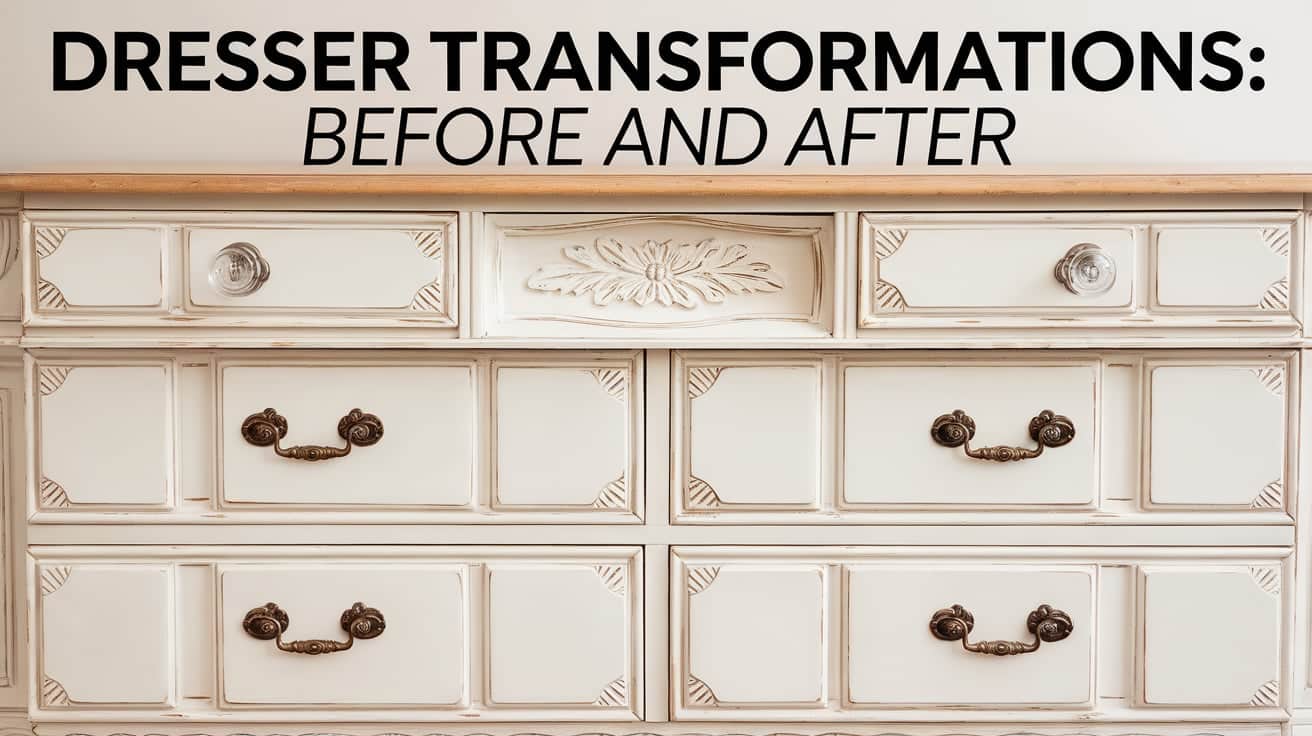Does your bedroom dresser sit there looking dull and worn out?
I know how frustrating it can be to look at old furniture that doesn’t match your style anymore.
But here’s something you might not know – that tired dresser can become your room’s star piece with just a few simple changes.
I’ve turned countless outdated dressers into statement pieces that my clients now love showing off.
The best part? You can do this too, without spending much money.
Let me show you my favorite dresser transformations and the exact steps I took to create them. These before-and-after stories will give you all the inspiration you need to start your own project.
Why Redo Your Dresser?
I know what you’re thinking – getting rid of that old dresser and buying a new one seems easier. But wait! Let me tell you why giving your current dresser a fresh look makes perfect sense.
First, it saves you money. A quality new dresser can cost hundreds or even thousands of dollars. With some paint and new hardware, you can update your existing piece for under $100.
Second, you’ll get exactly what you want. I’ve learned that finding the perfect dresser in stores can feel impossible.
Third, you’re helping the environment. I feel good knowing that updating furniture keeps solid pieces out of landfills. Plus, older dressers often have better construction than newer ones.
Finally, it’s satisfying! Trust me – the feeling you get when you see your completed project is worth every minute spent.
My Dresser Before the Transformation

Let me tell you about my old pine dresser that sat in my bedroom for years.
The finish had faded to a dull yellow-brown, and the brass handles looked tarnished and dated. Every morning, I’d look at it and sigh.
Here’s what I started with:
- A solid pine dresser from my parents’ house
- Six spacious drawers with working tracks
- Original brass hardware from the 1990s
- Basic, boxy design with straight lines
The problems I faced:
- Water rings stained the top surface
- Scratches marked the corners and sides
- One drawer pull kept coming loose
- The yellow-brown finish looked outdated
- Multiple scuff marks from moving
But here’s what made me keep it:
- The wood remained strong and stable
- All drawers opened and closed smoothly
- The size fit my space perfectly
- The simple design offered good options for updates
Looking at these details, I knew this dresser had more life in it. Sometimes good furniture just needs a fresh start – and that’s exactly what I planned to give it.
Paint vs. Stain – Choosing the Right Finish
When I work with old dressers, I often face this question from my clients: “Should we paint or stain?”
It’s not just about color – each option brings its own set of benefits and challenges to your furniture makeover project.
Let’s talk about paint first.
Paint has become my go-to solution for many projects, especially when working with pieces that have seen better days.
Think of paint as a fresh start for your dresser. It covers up those water rings, scratches, and mismatched patches that tell tales of years gone by.
However, paint isn’t without its drawbacks. Here’s what you should consider:
- It permanently covers the natural wood grain
- The prep work takes time and patience
- Multiple coats are often needed for best results
Now, let’s explore staining.
Staining feels like revealing a secret – it brings out the natural character of wood while adding color.
When I work with stain, I’m always excited to see how it enhances the wood’s natural patterns and gives depth to the surface.
It’s like giving wood a tinted glass through which its natural beauty shines.
Essential Tools and Materials Needed for Tranformation
| Materials | Tools |
|---|---|
| Milk Paint (Sweet Pickens and DIY White Swan) | French Round Brush |
| Gorilla Construction Adhesive | Screwdriver |
| All-Purpose Bondo | Putty Knife |
| Clear Wax | Stiff Bristle Brush |
| White Wax | Lint-free Rags |
| Amazing Mold Putty | Sandpaper |
| New Hardware/Knobs | JRB #12 Stencil Brush |
| Paint Sample for Touch-ups | Work Mat |
How to Transform Your Dresser with Paint
Step 1: Structural Repairs
Let’s begin with the foundation. Before thinking about paint or style, we need to make sure the dresser is sturdy and stable.
Key repairs include:
- Check if the back panel needs replacement or support
- Test each drawer for stability and smooth function
- Look for loose joints or wobbly sections
For significant repairs:
- Apply Gorilla Construction Adhesive to loose joints
- Hold sections in place with straps while drying
- Fill deep holes or damage with Bondo
- Let all repairs cure completely (usually 24 hours)
Step 2: Surface Preparation
This step makes the difference between an okay job and a great one. Proper prep ensures your paint adheres well and looks smooth.
Essential prep steps:
- Remove all hardware and store safely
- Sand rough areas until smooth
- Clean entire surface to remove dust and oils
- Check for missing details or trim
Step 3: First Paint Layer
The first coat sets the foundation for your final look. Take your time here – rushing will show in the end result.
Paint mixing and application:
- Mix milk paint with water (1:1 ratio)
- Stir until completely blended
- Keep drawers in place while painting
- Use long, smooth strokes
- Avoid painting drawer sides
Tips for best results:
- Work in small sections
- Keep a wet edge to prevent lap marks
- Let paint dry between coats
- Check coverage as you go
Step 4: Detail Work
This is where your dresser starts to come alive. Focus on the ornate areas that will make your piece stand out.
Detail painting process:
- Use French round brush for control
- Apply white paint to raised details
- Work from top to bottom
- Take breaks to check your work
Problem areas to watch:
- Corners and edges need extra attention
- Deep carvings require careful brushwork
- Touch up any drips immediately
- Clean brush often for best results
Step 5: Second Paint Layer
The second coat brings depth and full coverage. This layer perfects your color and hides any thin spots.
Application tips:
- Mix fresh paint to ensure consistency
- Focus on areas needing more coverage
- Use light pressure to avoid brush marks
- Check for missed spots in good light
Step 6: Waxing Process
Wax protects your work and adds depth to the finish. This step brings out the beauty of your paint job.
Waxing steps:
- Start with clear wax base coat
- Apply in small sections
- Work wax into all details
- Remove excess while wet
Adding depth:
- Apply white wax to edges
- Create subtle highlights
- Buff with lint-free cloth
- Build up layers as needed
Step 7: Final Touches
The last step brings everything together. This is where your dresser truly becomes complete.
Final steps:
- Install new hardware carefully
- Check drawer function
- Make any needed touch-ups
- Let cure for 24-48 hours
Before use:
- Test all drawers for smooth operation
- Check stability once more
- Clean any fingerprints
- Take photos of your beautiful work
For a more detailed tutorial, check out the video below:
My Dresser After (I am obsessed)

I can’t stop looking at my dresser now!
The transformation turned out better than I imagined. The soft white paint brightens my entire room, while the new hardware adds just the right touch of class.
The detailed trim work, which once looked tired and worn, now stands out beautifully against the fresh finish.
Those old water rings and scratches? Gone! The drawers slide smoothly, and the whole piece feels solid and renewed. Best of all, this dresser still keeps its vintage charm while fitting perfectly with my modern decor.
Every morning, I smile seeing how this simple update made such a big impact.
Caring for Your Newly Painted Dresser
Taking good care of your freshly painted dresser helps maintain its beauty for years to come.
Let me share my personal care tips that have worked well for my clients and my own pieces.
For the first two weeks:
- Handle drawers gently while paint fully cures
- Avoid placing heavy items on the surface
- Keep the dresser away from direct sunlight
Daily care is simple but important. I use a soft, dry cloth for regular dusting. For tougher spots, I lightly dampen the cloth – but remember, less water is better.
Never use harsh cleaning products; they can dull your finish and potentially damage the paint.
One trick I’ve learned is to place felt pads under items you keep on top. This prevents scratches and lets the surface breathe. If you notice small scratches, don’t panic. I keep a small amount of touch-up paint handy for quick fixes.
For seasonal maintenance:
- Check and tighten hardware as needed
- Look for any paint chips or wear spots
- Clean drawer tracks for smooth operation
Wrapping It Up
Your old dresser holds more potential than you might think. Through this guide, I’ve shown you how a tired piece of furniture can become a stunning focal point in your room.
From picking the right finish to proper care, each step builds toward creating something special.
Ready to start your project? Remember to prepare well, work carefully, and give your piece time to cure. The result will be worth every minute spent.
Still unsure? Start small.
Try updating just the hardware or testing paint on a hidden spot. Once you see the change, you’ll feel ready for the full makeover.








